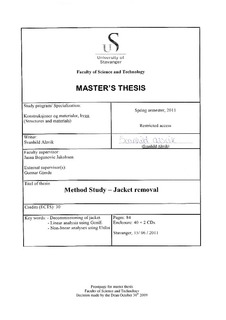| dc.contributor.author | Alsvik, Svanhild | |
| dc.date.accessioned | 2014-02-06T10:04:00Z | |
| dc.date.available | 2014-02-06T10:04:00Z | |
| dc.date.issued | 2011 | |
| dc.identifier.citation | | no_NO |
| dc.identifier.uri | http://hdl.handle.net/11250/183144 | |
| dc.description | Master's thesis in Structural engineering | en_US |
| dc.description.abstract | Decommissioning is a new marked in the petroleum industry. Many offshore installations are coming to the end of their planned lifetime. Hence, it will be a significant increase in decommissioning activity in the next couple of decades. When petroleum activities ceases the main rule is that everything has to be cleared and removed.
There exists only limited experience on the scale and nature of the decommissioning marked. A considerable increase in demand for competence and equipment for decommissioning of facilities is expected to arise. The marked is already developing; new technology has emerged and various removal concepts are under study.
Three different removal methods for jackets are studied in this document:
- Heavy lift removal method
- Vertical split of jacket
- Reversed launching
The jacket that is investigated consist of eight legs and has a steel weight of about 7 500 tonnes, and is seen as an ordinary jacket. Only inshore operations are investigated, and the jacket is assumed transported to a location in sheltered waters.
Heavy lift method is a removal method using heavy lifting vessels to lift and transport the jacket to shore. This method has been executed before and is well documented. A linear elastic analysis is carried out to investigate the structural integrity of the jacket during a lift operation. Sesam - GeniE software program is used to carry out the analysis.
The vertical split and the reversed launching operation has the aim to be alternative removal methods to the use of heavy lift vessels. Buoyancy Tank Assemblies (BTAs) developed under the Frigg Cessation Project are used in these alternative operations. Both the vertical split and the reversed launching method are developed on the idea to use buoyancy forces and float the jacket to quay were it can be dismantled.
The idea behind the vertical split method is to cut the jacket into two vertical sections and float them, using the BTAs, to quay. The reversed launching is based on the idea to use the same procedure to remove the jacket as used when it was installed. The BTAs and a Purpose Made Barge will provide the necessary buoyancy force to float the jacket in one section to shore. Nonlinear, dynamic analyses are carried out for both the alternative jacket removal methods. Usfos software program are used to perform the analyses.
How to execute the different removal methods are studied and the structural integrity of the jacket has been analysed and documented. The structural integrity of the jacket is kept in the heavy lift removal method and the reversed launching method. Measures have to be taken to do the vertical split removal method feasible for the type of jackets that is analysed. In further studies additional analysis is necessary to verify if the reversed launching method is feasible. The reversed launching method has, in this study, turned out to have a larger possibility to be a competitive removal method than the vertical split method. Heavier jacket may be easier to remove using the reversed launching method, and hence it is more competitive with regards to the use of heavy lift vessels. | en_US |
| dc.language.iso | eng | no_NO |
| dc.publisher | University of Stavanger, Norway | no_NO |
| dc.relation.ispartofseries | Masteroppgave/UIS-TN-IKM/2011; | |
| dc.subject | materialteknologi | en_US |
| dc.subject | byggkonstruksjoner | en_US |
| dc.subject | decommissioning | en_US |
| dc.subject | linear analysis using genie | en_US |
| dc.subject | nonlinear analyses using usfos | en_US |
| dc.title | Method study - Jacket removal | no_NO |
| dc.type | Master thesis | no_NO |
